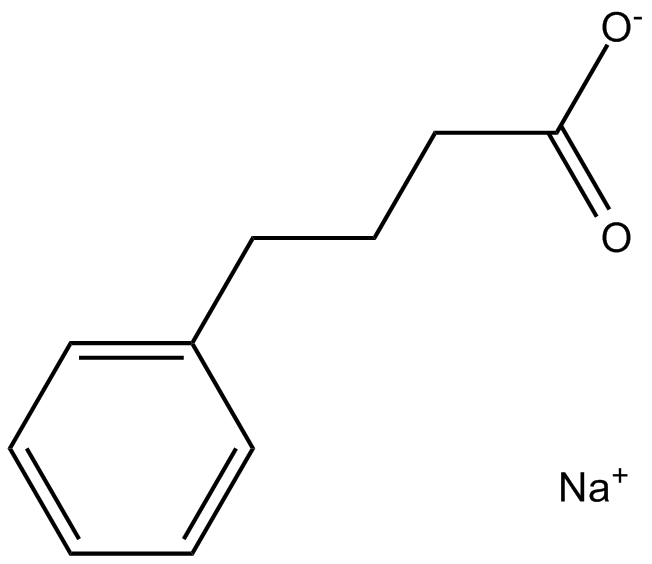Sodium Phenylbutyrate (Synonyms: Benzenebutanoic Acid, NSC 657802, TriButyrate) |
| Catalog No.GC15002 |
A chemical chaperone
Products are for research use only. Not for human use. We do not sell to patients.

Cas No.: 1716-12-7
Sample solution is provided at 25 µL, 10mM.
Sodium phenylbutyrate is an inhibitor of HDAC and endoplasmic reticulum (ER) stress, used in cancer and infection research.
Sodium phenylbutyrate is an inhibitor of HDAC, inhibits the growth of NSCLC Cell Lines at 2 mM. Sodium phenylbutyrate in combination with ciglitizone results in enhanced growth arrest of cancer cells[1]. Sodium phenylbutyrate (0-5 mM) inhibits ASFV infection in a dose-dependent manner. Sodium phenylbutyrate also inhibits the ASFV late protein synthesis and disrupts the virus-induced H3K9/K14 hypoacetylation status. Sodium phenylbutyrate and enrofloxacin act synergistically to abolish ASFV replication[2]. Addition of bafilomycin A1 results in accumulation of LC3II, whereas Benzenebutyric acid (4-PBA) substantially reduces this accumulation. LPS decreases the level of p62, whereas Benzenebutyric acid reverses this decrease upon LPS stimulation for 48 h. The percentage of cells with LPS-induced AVOs is increased at 48 h, whereas Benzenebutyric acid significantly reduces this percentage. Specifically, the percentage of cells with AVOs decreases from 61.6% to 53.1% upon Benzenebutyric acid treatment, supporting that Benzenebutyric acid inhibits LPS-induced autophagy. As a positive control for autophagy inhibition, bafilomycin A1 is used. The percentage of cells with LPS-induced AVOs is reduced by bafilomycin A1 treatment. The decreased OC area and fusion index observed after Benzenebutyric acid treatment are not observed with knockdown of ATG7. Inhibition of NF-κB using BAY 11-7082 and JSH23 reduce the LC3 II level upon LPS stimulation and completely abolish the inhibitory effect of Benzenebutyric acid on LPS-induced effects[3].
LPS induces significant bone loss and decreases bone mineral density (BMD), bone volume (BV/TV), and trabecular thickness (Tb. Th) compared with PBS alone, whereas trabecular space (Tb. Sp.) is increased. Sodium phenylbutyrate attenuates LPS-induced bone loss. Treatment with Sodium phenylbutyrate increases BMD, BV/TV, and Tb. Th. compared with LPS alone, in addition to decreasing the enlargement of Tb. Sp., but no change is observed when mice are treated with Sodium phenylbutyrate alone. OC.S/BS as assessed by TRAP staining is also significantly reduced when Sodium phenylbutyrate is administered to LPS-treated mice. However, OC.N/BS tends to decrease, although not with statistical significance, when mice are treated with Sodium phenylbutyrate and LPS. These results indicate that the effect of Sodium phenylbutyrate on OC from LPS-treated mice is to reduce its size rather than number. Consistent with these findings, a marker of bone resorption in vivo, serum CTX-1 which is elevated by LPS treatment is decreased when Sodium phenylbutyrate administered to LPS-injected mice. However, co-treatment with Sodium phenylbutyrate do not significantly affect the levels of serum ALP and osteocalcin, 2 markers of bone formation in vivo, compared with LPS alone. Sodium phenylbutyrate also reduces the LPS-induced rise in serum MCP-1, indicating that Sodium phenylbutyrate decreases systemic inflammation induced by LPS[3].
References:
[1]. Chang TH, et al. Enhanced growth inhibition by combination differentiation therapy with ligands of peroxisome proliferator-activated receptor-gamma and inhibitors of histone deacetylase in adenocarcinoma of the lung. Clin Cancer Res. 2002 Apr;8(4):1206-12.
[2]. Frouco G, et, al. Sodium phenylbutyrate abrogates African swine fever virus replication by disrupting the virus-induced hypoacetylation status of histone H3K9/K14. Virus Res. 2017 Oct 15;242:24-29.
[3]. Park HJ, et al. 4-Phenylbutyric acid protects against lipopolysaccharide-induced bone loss by modulating autophagy in osteoclasts. Biochem Pharmacol. 2018 May;151:9-17.
Average Rating: 5 (Based on Reviews and 30 reference(s) in Google Scholar.)
GLPBIO products are for RESEARCH USE ONLY. Please make sure your review or question is research based.
Required fields are marked with *




















